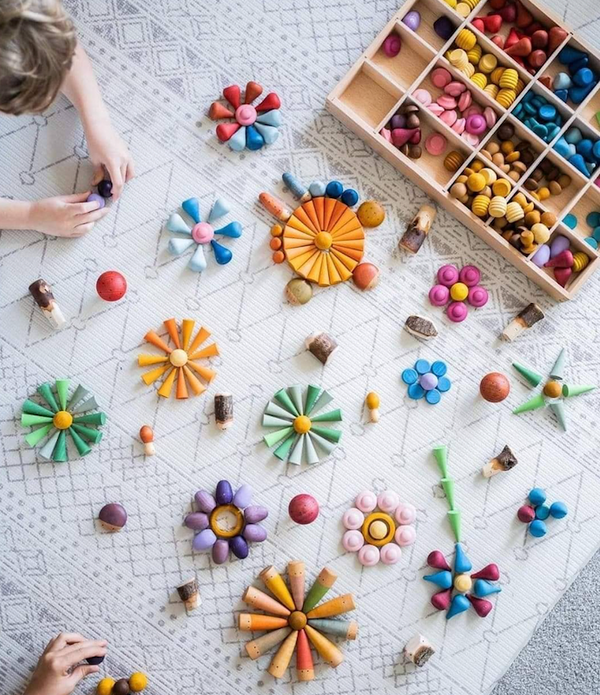
Dry Sensory play ideas - not wet and sticky!
LAST UPDATED: 30 SEP 2025
Have you ever wanted to try sensory play with your baby or toddler, but you are worried about sticky, slimy and water going everywhere?
Well, you are not alone. We have a list of sensory play ideas that are all 'dry', so your baby won't need a bath afterwards.... and your carpet will thank you.

Why sensory play?
Sensory play allows children to develop a huge number of skills when they think they’re just having fun!
So what is sensory play? It is any type pf play that stimulates the senses – that includes sight, smell, touch, taste, hearing and proprioception (body awareness). Stimulating the senses is incredibly important for the way our brain stores information.
A good example of how powerful senses can be is when you listen to a certain song or smell a certain type of food and a memory comes flooding in that you haven’t thought about in a while.
Examples of sensory play

Sensory play doesn't have to be hard can be things like;
- a simple bucket of water
- having a bubble bath
- dyed rice/pasta
- play dough
- shaving foam
- musical instruments
- sand
- wooden objects
- cereal with toys
I know what you’re thinking already… “but sensory play is too messy!”
Sensory play can be messy, but it doesn’t have to be wet and sticky. Some kids actually don’t like sticky activities like slime or jelly.
How to prepare for sensory play

Before I tell you some easy dry sensory play activities, you need to make sure you’ve prepared your environment.
If play needs to be indoors:
- Remove any rugs,
- Cover up carpets,
- Or get your hands on a Grace & Maggie play mat – otherwise those little grains of rice and cereal will find their way into every nook and cranny of your house.
This makes clean up as easy as a quick vacuum or sweep.
4 easy dry sensory play activities
Here are four easy dry sensory play activities that you can do at home that don’t take a lot of preparation and they are nice and dry.
- Dried Black Bean Construction Site with Trucks
- Rainbow Rice with Scoops
- Farm Small World Play with Cereal
- Nature sorting box
Through these four simple activities, children will develop their fine motor skills for scooping and threading, imaginary and symbolic play, speech and language, problem solving and they will be exposed to new sensations so they can learn more about the world around them.
Dried Black Bean Construction Site with Trucks

Black beans can be picked up at your local health food store, Woolies, Coles or IGA.
Who knew this delicious legume could also double as a serious construction site set up for the budding builder?
An added advantage is that these dried beans can be stored in an airtight container for several years, allowing you to reuse them for various sensory play activities.
What you will need:
- 1 kilo of Dried black beans (at the time of writing this article, this would cost around $7 from Woolworths)
- Long tupperware container (sensory tub)
- Mini trucks / cars / diggers
- Cardboard (optional)
- Tape (optional)
How to play:
The large Tupperware container doubles as the storage box. This means once you are done playing, the lid can go on and the container can be popped straight away - easy.
Place the black beans in the sensory tub, and pop the diggers, cars and trucks on top. Don’t arrange too heavily; let your little one go wild with their imagination.
Cardboard and tape can be used to create ramps and bridges. Again, this is at your discretion and depends on your little one's age. Older children might construct these parts themselves or with your help. For children under 18 months, this is not really necessary.
Rainbow rice with scoops

Rice is undoubtedly one of the most popular sensory bases, as children love to play with it, scoop it, pour it, and fill containers with it. However, if you add rainbow colours to the rice, it takes its appeal to a whole new level!
Check out the incredible colours you can achieve with food dye.
The good news is that you won't have to prepare the rice over and over, as rainbow rice can last forever if stored in an airtight container.
What you will need:
- White Rice
- a Ziploc bag
- food colouring and white vinegar
- Tray
- scoops
- little containers
- large tupperware tray/container
Preparation:
First, pour around two cups of rice into a plastic bag. In a separate bowl, mix a tablespoon of vinegar with some food colouring. Add the mixture to the rice in the bag and shake it until the rice is evenly coated. If the colour is not bright enough, you can add a bit more food colouring.
Once the rice is coated with the mixture, spread it thinly on a baking tray to dry, following the same method as described above. The drying process usually takes between thirty minutes to an hour, depending on the moisture content of the rice.
Repeat the same process for all of the different colours, and voila! You will have your rainbow rice ready to use.
How to play:

There are several ways to play with coloured rice. You could pour it all into the sensory container. Side by side in a rainbow. Then let your child run their fingers through it. Then, have something they could transfer the rice into. E.g., little containers or patty cases.
Another option is to transfer it into small containers, making it easier for your child to scoop it out using a spoon.
Encourage your toddler to pour the rice into different sections of the containers. Initially, let them experiment by pouring and playing with the rice. Later on, ask them to fill up one container at a time before moving to the next one.
Farm Small World Play with Cereal

This example is a form of imaginative role play. It can be great for both the little babies and right up to school-age children.
Small world play is a favourite in our household, and this activity was no exception. Not only is it great for stimulating imagination and language skills, but it's also incredibly fun!
What you will need:
- Your choice of cereal. For example, Weetbix and or oats
- Large tray/ tupperware / cut-down cardboard box
- Plastic or wooden farm toys
How to play:
So for this one, there are so many variations, and it really comes down to what you have in the house. As pictured above, this version has frozen peas, mini shredded wheat cereal, and cocoa powder. But you can use whatever you like.
If you are thinking you are going to reuse the play materials (so not the frozen peas), then you could use a large Tupperware container, pop the lid on after play and store. But if its going to be a play and then done kind of thing. Maybe only a cardboard box could be used that is cut down and recycled later on.
To contain the mess, a tray or box with higher sides would help. However, flatter trays are easier for younger ones to access.
Depending on age, you might need to demonstrate how to play with this activity. If they are a little older, they might start playing straight away. They can feed the animals, crush and mix food, and let the pigs wallow in the mud.
You could start making animal noises and ask them, “What does the pig say?”
If you have options like cocoa and peas, maybe make this one an outside activity.

An alternative could be without the cereal.
Nature sorting box

A Sensory Nature Sorting Box is an excellent post-Nature walk activity for children. It provides an opportunity for them to engage in a hands-on exploration of their nature finds and to thoroughly examine their shapes, smells, colours, and textures.
There are a number of ways to go about this activity. You could have collected the items first. Or you can make the collection process part of the activity. I have also included children's scissors, as my kids seem to like to cut everything up.
Depending on ages, you can leave the scissor part out. Adding in the scissors helps in developing fine motor and scissor skills, making it an all-around valuable learning experience.
Warning: Please make yourself aware of any local plants and berries that are not safe to touch. If you don't know if something is safe, then avoid touching it.
What you will need:
- Basket
- Sorting Tray
- Children's scissors
How to play:
You and your child can go for a lovely nature walk. Remember please don’t pick flowers from people's gardens, they will not be too happy about this - and it’s a good time to teach your child about this too.
Look out for things such as;
- Grasses
- Twigs
- Flowers
- Acorns
- Rocks
- Tanbark
- Seed pods
- Shells
If you live near the beach or some wetlands this can be the perfect place to find some different natural objects to collect. Spend time with your child collecting objects. Talk about smells, textures, colours, shapes and sizes.
When you return home, lay out all the objects on your playmat and let the sorting begin. If you have a tray with sections this is perfect, or you could sort on a cardboard box. It’s up to you.
If you want to initiate the activity, you could tell your child to sort on colours, sizes, textures or types.
If your child is into cutting like mine are. Get the child-safe paper scissors out. Mine use the Crayola ones for cutting paper, Play-Doh and leaves.
How do you keep sensory play clean?
Using a large, shallow storage bin that fits under the bed is an effective way to contain sensory play materials. To keep the mess under control, you can place a smaller container inside the larger one.
Using a playmat can also help keep an unwritten boundary for where the play should be happening.
What should sensory play look like?
It should look like a whole lot of fun!
Sensory play often prioritises stimulating touch, sight, and hearing because these senses are the most accessible.
During the early stages of childhood development, children primarily engage with the world through their five senses (touch, taste, hearing, sight, and smell).
Safety with sensory play
As a caregiver, it is your responsibility to determine what activities are safe for your children. If you are uncertain about an activity's safety or age appropriateness, seek advice from your local Maternal Child Health Nurse.
Please note that the activities mentioned here require adult supervision.
Additionally, you should exercise appropriate and reasonable caution when using materials that may be harmful or when dealing with small items that could pose a choking hazard. It is essential to observe caution and prioritise safety in all activities.
Show us your sensory play on your Grace & Maggie play mat over on the socials!
By Alex Trichilo (Speech Pathologist and Mum of Three)
Online store - Open 24 hours
orders@graceandmaggie.com.au
PO Box 2852, Cheltenham, VIC 3192
Melbourne, Victoria, Australia
 Shop Now with Afterpay
Shop Now with Afterpay 
